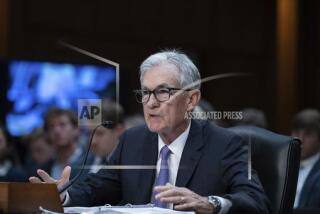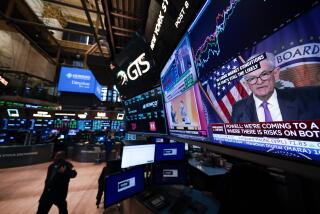Slumping Dollar Stirs Debate About Policy
The dollar slumped Monday to new multiyear lows against major rivals after Treasury Secretary John Snow indicated the Bush administration is happy with the help the falling currency provides U.S. exporters.
That could mean there will be no stopping the dollar’s decline anytime soon, some analysts said -- which would be welcome news for manufacturers in California and across the nation as the currency’s slide makes U.S. goods cheaper abroad.
For the record:
12:00 a.m. May 14, 2003 For The Record
Los Angeles Times Wednesday May 14, 2003 Home Edition Main News Part A Page 2 1 inches; 57 words Type of Material: Correction
Slumping U.S. dollar -- A chart with an article about the U.S. dollar in Tuesday’s Business section incorrectly said the Taiwan dollar’s value is fixed against the U.S. dollar. The Taiwan dollar officially is a floating currency, but the nation’s central bank actively manages the currency to keep its value from fluctuating significantly against the U.S. dollar.
So far, the risks of a weaker buck are taking a back seat to the potential benefits. The risks include that foreigners might be unwilling to finance America’s huge budget and trade deficits as the dollar falls, and that consumers may face higher prices for imported goods.
On Monday, the euro rose to $1.154 in New York, up from $1.149 on Friday and the highest since January 1999, when the currency was formally introduced for 12 European countries.
The Canadian dollar, Australian dollar and Swiss franc also hit their highest values in at least three years compared with the U.S. currency.
Swings in the dollar’s value haven’t been much of a conversation topic for most Americans since World War II unless they’ve been traveling overseas. But for U.S. exporters the dollar’s fluctuations can matter greatly. And from 1995 through 2001 a surging buck made it tougher for many exporters to compete overseas by automatically making their goods more expensive for foreign buyers -- or by shrinking their profit margins if they chose to keep prices level.
Since early 2002, however, the dollar has been in a sharp decline against other major currencies, especially the euro.
A weaker dollar helps U.S. companies in two ways: It can make their goods cheaper overseas, and it also can make foreign goods more expensive for U.S. consumers. That latter effect can give U.S. firms more pricing power at home, allowing them to raise prices or at least avoid cutting prices.
Although it isn’t always clear why a currency’s value rises or falls, the health of the economy behind the currency is supposed to be a principal factor.
In the case of the United States, the 2001 terrorist attacks, last year’s rash of corporate scandals and the growing federal budget deficit all have been factors mentioned as weighing on the dollar’s value.
What’s more, with U.S. interest rates at 40-year lows -- and below the levels that prevail in every other major industrialized nation other than Japan -- there has been less incentive for foreign investors to seek dollar-denominated bonds and other fixed-income securities.
Whatever the root cause, the dollar’s weakness has fed on itself this year. That has spurred questions about how low the Bush administration is willing to see the buck go.
Officially, the administration including Treasury Secretary Snow continue to insist the White House favors a “strong” dollar. But on Sunday, Snow said on ABC’s “This Week” news program that “when the dollar is at a lower level, it helps exports, and I think exports are getting stronger as a result.”
That raised more suspicions among currency traders that the administration is content to see the dollar fall further.
Likewise, the Federal Reserve’s decision last week to cite the risk of deflation appeared to erase any possibility that the central bank might raise interest rates soon to defend the dollar.
At the National Assn. of Manufacturers in Washington, Frank Vargo, vice president for international economic affairs, said Monday that the group estimates the balance of trade could shift by $100 billion in favor of U.S. exporters in 2004 because of the dollar’s decline.
So far, however, Vargo said his group has heard only anecdotal evidence from members that the dollar is helping them.
“Some of them say they’re being asked for quotes again” from foreign customers, he said. The typically long lag time between currency changes and their fallout means many companies will feel the effects in 2004, he said.
For the Bush administration, that would coincide with the presidential election cycle, economists noted.
The principal risk of a weakening dollar is that it could make foreign investors less willing to buy and hold U.S. assets, because each drop in the dollar’s value slashes the worth of foreigners’ U.S. holdings.
But government data show foreigners continued to be net investors in U.S. securities in 2002 even as the dollar fell.
Foreigners bought a net $507 billion in long-term U.S. securities last year, down just marginally from $520 billion in 2001.
Official data on foreign buying for the last two months aren’t available. But the powerful rallies in stock and bond markets since mid-March suggest that foreigners either aren’t huge sellers, despite the dollar, or that any selling has been met by strong domestic demand.
Given the massive U.S. hunger for foreign capital to fund the trade and budget deficits, a weak dollar becomes a problem “if you have some evidence of capital flight -- if the dollar, bonds and stocks all are falling at the same time,” said Craig Larimer, currency strategist at Banc One Capital Markets in Chicago. But that isn’t the story this year.
Another risk is that prices of imported goods could begin to rise fast enough to fuel inflation concerns.
In the 12 months through March a U.S. index of imported goods, other than oil-related products, rose 2.4%, compared with a drop of 4.2% in the previous 12 months.
Yet the Federal Reserve’s warning about deflationary forces indicates it isn’t worried that the dollar has become too depressed. And many economists concur, noting that the dollar still is far stronger than it was in the early 1990s.
Some say that worries about dollar fallout could deepen if exporting giant China were to allow its currency to rise against the buck, potentially raising pricing pressures. China and some other Asian nations peg their currencies to the dollar, a practice that keeps U.S. companies from gaining any competitive currency advantage over Chinese firms.
Vargo said his group is pressing the White House to get China to end its currency peg.
For now, the U.S. economy overall may be enjoying the best possible dollar scenario, said Joseph Carson, economist at Alliance Capital in New York: The dollar is weakening against developed countries to which U.S. exporters sell a lot of goods, while it is remaining level against the currencies of China and other Asian nations from which the U.S. imports huge quantities of consumer goods.
“It’s almost perfect,” Carson said.
*
(BEGIN TEXT OF INFOBOX)
Shifting currency values: A sampling
The currencies of Australia, Canada and the euro-zone nations have risen sharply against the dollar this year. But the dollar has been flat against the Chinese and Taiwanese currencies because those nations keep their exchange rates fixed.
*--* Value of currency, in U.S. dollars Pctg Country/currency Dec. 31 Monday change Australia/dollar $0.561 $0.648 +15.5% Canada/dollar $0.635 $0.719 +13.2 Euro zone/euro $1.050 $1.154 +9.9 Switzerland/franc $0.724 $0.762 +5.2 Mexico/peso $0.0963 $0.0981 +1.9 Japan/yen $0.0084 $0.0085 +1.2 Taiwan/dollar $0.0288 $0.0289 +0.3 China/yuan $0.121 $0.121 none Britain/pound $1.611 $1.609 -0.1
*--*
Source: Bloomberg News
More to Read
Inside the business of entertainment
The Wide Shot brings you news, analysis and insights on everything from streaming wars to production — and what it all means for the future.
You may occasionally receive promotional content from the Los Angeles Times.










